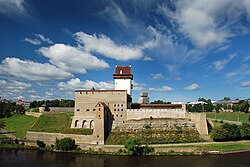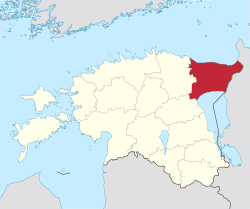Ida-Viru County
| Ida-Viru County | |||
|---|---|---|---|
| County of Estonia | |||
 |
|||
|
|||
 |
|||
| Country | Estonia | ||
| Capital | Jõhvi | ||
| Government | |||
| • Governor | Andres Noormägi | ||
| Area | |||
| • Total | 3,364 km2 (1,299 sq mi) | ||
| Population (Jan 2016) | |||
| • Total | 146,506 | ||
| • Density | 44/km2 (110/sq mi) | ||
| ISO 3166 code | EE-44 | ||
| Vehicle registration | I | ||
| Website | www |
||
Ida-Viru County (Estonian: Ida-Viru maakond), or Ida-Virumaa, is one of 15 counties of Estonia. It is the most north-eastern part of the country. The county contains large deposits of oil shale - the main mineral mined in Estonia. As oil shale is used in thermal power plants, the earth in Ida-Viru contains most of Estonia's energy resources. The capital of the county is the town of Jõhvi which is administratively united with the Jõhvi Parish. In January 2016 Ida-Viru County had a population of 146,506 – constituting 12.6% of the total population in Estonia.
During the latter part of the period of Soviet rule of Estonia, Ida-Virumaa was called Kohtla-Järve district, and its administrative capital was Kohtla-Järve.
The County Government (Estonian: Maavalitsus) is led by a Governor (Estonian: maavanem), who is appointed by the country's government for a term of five years. The current governor of Ida-Viru county is Andres Noormägi.
In January 2010, the population of Ida-Virumaa was 168,656, which makes it the second largest county in Estonia (after Harjumaa, which includes Tallinn). 44.6% of the population are men and 55.4% women.
By ethnic origin, on 1 January 2013, 72.8% of the population were Russians, 19.5% were Estonians, 2.3% were Ukrainians, 2.2% were Belarusians and 0.9% were Finns. This is dramatically different from the rest of Estonia, where most counties are over 80% ethnic Estonian.
...
Wikipedia


